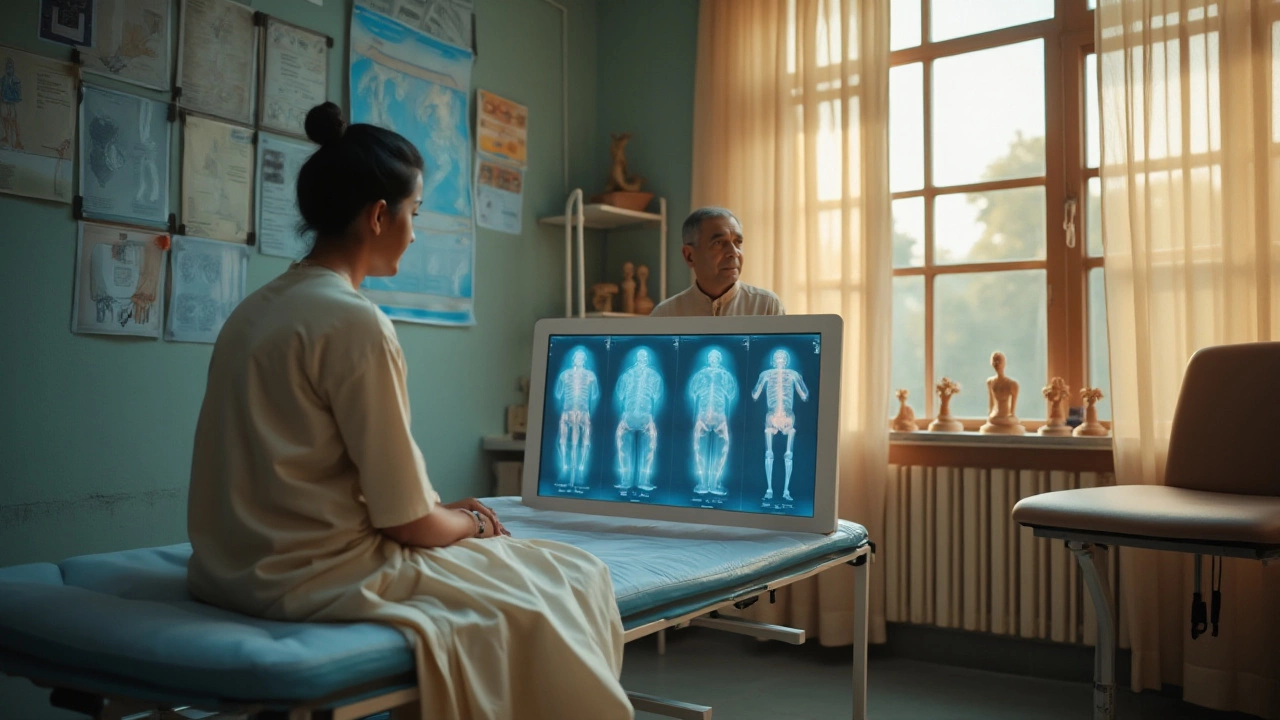
Taking care of your bones and joints is essential to maintain a healthy and active lifestyle. Whether it’s a nagging knee pain or a sudden fracture, knowing who the right specialist to consult is can make all the difference. In the realm of medicine, orthopedic doctors are the go-to experts who diagnose and treat a variety of conditions affecting bones, joints, and connective tissues.
It’s not uncommon to find people unsure about what orthopedic doctors actually do or when it’s time to see one. With a blend of effective diagnosis and tailored treatments, these specialists address a wide range of issues from routine injuries to chronic conditions. Understanding their roles and how they can help is key in fostering your musculoskeletal health.
- Understanding Orthopedic Specialists
- Common Bone and Joint Conditions
- Choosing the Right Orthopedic Doctor
- What to Expect During a Consultation
- Tips for Maintaining Bone and Joint Health
Understanding Orthopedic Specialists
Orthopedic specialists, commonly referred to as orthopedic doctors, play a pivotal role in maintaining the harmony of our musculoskeletal system. These are the medical professionals you turn to for all matters concerning bones, joints, tendons, ligaments, and muscles. Often our daily hustle can lead to niggling pains and unexpected injuries, making these specialists invaluable. They undergo extensive training which involves years of medical schooling, followed by specialized residencies. Their knowledge spans both surgical and non-surgical procedures, allowing them to offer comprehensive care. Many orthopedic doctors focus on certain areas, like pediatrics, sports medicine, or trauma, ensuring tailored patient care in their chosen specialties.
Orthopedic specialists are adept at managing an array of conditions. Their expertise encompasses ailments such as arthritis, osteoporosis, and complex fractures. They also address sports injuries that athletes dread. The field is fascinating due to its dual focus on improving function and alleviating pain. Innovations in this space, such as minimally invasive surgery and advanced prosthetics, have dramatically enhanced patient outcomes. It’s important to note that these specialists also emphasize prevention, advising on lifestyle choices and exercises to maintain bone health.
A typical consultation with an orthopedic specialist is detailed and methodical. They conduct thorough assessments using clinical evaluations and advanced imaging techniques, including X-rays and MRIs. Such comprehensive analysis aids in accurate diagnosis and effective treatment planning. The relationship between patient and doctor is vital; thus, communication stands at the forefront. As quoted by Dr. Sarah Johnson, a renowned orthopedic surgeon,
"An open dialogue with patients about their concerns and treatment options is as crucial as the technical skills we possess."This approach not only fosters trust but also empowers patients to make informed decisions about their health.
While navigating the world of orthopedic care, understanding the different types of orthopedic specialists can be quite enlightening. Subspecialties range from sports orthopedics to hand surgery, each addressing a specific facet of musculoskeletal health. Aspiring orthopedic doctors often choose their path based on interest and the impact they wish to have. Given that the aging population is on the rise, there is growing demand for expert care in geriatrics, focusing on conditions like hip fractures and arthritis. This demographic trend underscores the significance of orthopedic care for maintaining quality of life across generations.
Common Bone and Joint Conditions
Our bones and joints form the framework that supports our bodies, enabling us to move and perform daily activities with ease. However, several conditions can affect them, leading to discomfort or disability if not addressed properly. One of the most prevalent issues is arthritis, which has over a hundred distinct types. Rheumatoid arthritis and osteoarthritis are among the most common, characterized by inflammation and pain due to the deterioration of cartilage. As the cartilage wears away, bones rub against each other, causing swelling and stiffness, primarily in the knees, hips, and fingers.
Osteoporosis is another widespread concern, especially amongst the elderly and post-menopausal women. This condition involves the gradual loss of bone density and strength, making bones porous and brittle. Consequently, individuals are at a higher risk of fractures, even from minor falls. This silent disease often goes unnoticed until a break occurs, leading many to seek help from an orthopedic doctor only when the damage is already significant. Regular screening and a diet rich in calcium, coupled with weight-bearing exercises, are recommended for prevention. According to the International Osteoporosis Foundation, approximately one in three women and one in five men over the age of 50 will experience osteoporotic fractures in their lifetime.
Fractures, indeed, are not limited to osteoporosis sufferers. These injuries can result from traumatic incidents like falls, vehicle accidents, or sports injuries. Distal radius fractures (commonly known as wrist fractures) and femoral fractures are frequently seen in orthopedic hospitals. Effective treatment requires not only precision in resetting the bone but also careful rehabilitation to ensure optimal healing and function. A quote I came across drives this home:
"The key to successful fracture management lies in the initial care provided by both the patient and the orthopedic team." - American Academy of Orthopaedic Surgeons
On the topic of sports injuries, conditions such as ACL tears and rotator cuff injuries are often mentioned. Athletes frequently experience these due to repetitive strains and high-impact activities. The anterior cruciate ligament (ACL) is particularly susceptible in sports requiring swift changes in direction, like soccer and basketball. On the other hand, rotator cuff injuries often plague swimmers and baseball players, affecting shoulder stability and motion. To mitigate these risks, engaging in proper warm-up routines, strength training, and using appropriate techniques is vital.
Finally, we must address tendinitis, a condition born from overuse rather than acute injury. Constant repetition of certain motions often leads to inflammation of the tendons, with the Achilles tendon and elbow tendons being common victims. This is where understanding body mechanics and pacing oneself becomes essential. Incorporating rest days and varying activities can serve as preventive measures for such conditions. Nearly anyone partaking in regular physical activity is susceptible, yet with awareness and intervention, serious complications can often be avoided.
Understanding these common bone and joint conditions creates an avenue for proactive measures, whether through lifestyle adjustments or timely medical consultations. Seeking the expertise of a bone specialist can provide much-needed guidance and care, ensuring an active, healthy life with fewer setbacks.

Choosing the Right Orthopedic Doctor
Selecting the best orthopedic doctor for your needs can significantly influence your recovery and ongoing health. It’s important to consider several factors when making this critical decision. First, evaluate the doctor’s credentials and education. A board-certified orthopedic specialist has undergone rigorous training and has demonstrable expertise in the field. This certification ensures that they meet specific standards essential for patient care.
Another key consideration is the doctor's experience, especially regarding the specific condition or procedure you need help with. If you’re dealing with a knee issue, for instance, a doctor who frequently performs knee surgeries may be preferable. Research suggests that higher volumes of specific surgeries usually lead to better outcomes, thanks to the doctor’s refined technique and familiarity with possible complications.
Patient reviews can be a treasure trove of insight. Reviews shed light on experiences with communication, wait times, and personal interactions with the doctor and their staff. A friendly and empathetic approach often makes a difference for patients coping with pain and anxiety. As Maya Angelou famously said,
"People will forget what you said, people will forget what you did, but people will never forget how you made them feel."This holds true in healthcare as much as anywhere.
Besides reviews, logistical factors like the location of the doctor's practice and hospital affiliations matter. Ensuring the practice is convenient to visit and offers comprehensive services, including imaging and physical therapy, can streamline your care. Additionally, affiliation with a reputable orthopedic hospital can be a marker of quality since top hospitals maintain high standards for their staff.
Insurance coverage is another practical aspect that shouldn’t be overlooked. Check whether the doctor's practice accepts your insurance plan to help manage treatment costs effectively. This might involve some phone calls to your insurance provider and the doctor’s office to clarify coverage details for specific services or procedures.
Finally, trust your instinct when meeting a potential orthopedic specialist. Effective communication and a sense of empathy from your doctor can be reassuring. They should listen carefully to your concerns, explain medical terms in a way you understand, and involve you when deciding on treatment plans. Feeling comfortable and understood plays a vital role in your treatment journey and helps build a productive doctor-patient relationship.
What to Expect During a Consultation
When visiting an orthopedic doctor, understanding the dynamics of a consultation can greatly ease any anxiety. From the outset, you’ll meet the attentive receptionist or assistant who helps with the paperwork and guides you to where your consultation will take place. Once seated in the examination room, a nurse may come in to check your vital signs or inquire about any immediate concerns or symptoms you’re experiencing. This is a vital step, setting the groundwork for the orthopedic doctor to understand your condition better.
Expect the doctor to then arrive and greet you, a gesture that conveys both warmth and professionalism. As they begin understanding your case, they'll likely start with questions about your medical history and the specific symptoms affecting your bones and joints. They might ask about the onset of pain, any triggering activities, and your lifestyle habits. It's essential to provide comprehensive and truthful answers, as this information is crucial for diagnosing your issue precisely. Don’t hesitate to share any concerns or ask questions during this time.
Physical Examination and Diagnostic Tests
If needed, the doctor may proceed with a physical examination, during which they will keenly observe your range of motion, joint stability, and muscle strength. They might perform specific tests to pinpoint the source of your discomfort. The orthopedic examination is very thorough yet gentle, ensuring that you remain at ease throughout the process. Following the physical exam, diagnostic tests such as X-rays or MRI scans may be recommended to gain detailed insights into your condition. These tests can reveal anything from fractures to arthritis or more complex conditions.“The X-ray, around since the 1800s, remains one of the most instrumental tools in orthopedic diagnostics,” says Dr. John Doe, a renowned orthopedic surgeon.
Discussion and Treatment Plan
After gathering all necessary information, your doctor will sit down with you to discuss their findings. This part of the consultation is often the most enlightening, where all the pieces come together to form the big picture of your bone or joint health. They will evaluate your diagnosis and explain in understandable terms what it entails. Next, they’ll outline potential treatment options, ranging from medication or physical therapy to surgical interventions if necessary. Experts say that around 90% of musculoskeletal complaints can be effectively managed without surgery, which is reassuring for many patients. Remember to ask for clarity about each option and don’t shy away from discussing the potential risks involved.Your orthopedic consultation is not just about addressing immediate issues but also about fostering a collaborative relationship with your specialist. Being informed and active in your healthcare decisions ensures that treatment is specifically tailor-made for your needs, resulting in better health outcomes.

Tips for Maintaining Bone and Joint Health
Our bones and joints are the very foundations of our physical movement. Keeping them in top shape is not just about addressing occasional aches and pains; it’s about maintaining a lifestyle that supports long-term mobility and vitality. First and foremost, nutrition plays a pivotal role in bone health. A diet rich in calcium and vitamin D is essential. You can find these nutrients in dairy products, leafy greens, and fatty fish like salmon. Vitamin D is particularly unique, as our body can produce it upon exposure to sunlight, so a few minutes of sun each day can work wonders.
Exercise is another cornerstone in the care of bones and joints. Weight-bearing activities, such as walking, jogging, or dancing, bolster bone strength, while flexibility exercises like yoga enhance joint range and reduce stiffness. It’s important to remember to start any new activity slowly and be mindful of your body’s signals, as overdoing it can lead to injury. Regular physical activity not only helps build and maintain bone density but also supports muscle strength, which in turn stabilizes and protects joints.
Maintaining a healthy weight is also imperative. Excess weight puts undue pressure on joints, especially those in the lower body, such as knees and hips, which may lead to faster wear and tear. Shedding even a few pounds can significantly lessen this pressure, reducing the risk of joint injuries. Did you know that for every pound you lose, you reduce the load on your knee joint by four pounds? Reducing this mechanical stress can prevent potential complications associated with joint degeneration over time.
"The key to preventing musculoskeletal disorders is a proactive approach that combines a balanced diet, regular exercise, and making mindful choices about the body’s movements," recommends Dr. Susan Edwards, renowned orthopedic specialist.
Hydration is often overlooked but equally important. Water helps maintain the lubrication of joints. Maintaining adequate hydration levels supports the synovial fluid within our joints, which is vital for cushioning bones and ensuring smooth movement. Aim for at least eight glasses of water a day, adjusting for higher activity levels or warmer weather.
Finally, avoid smoking and excessive alcohol consumption, as both have been linked to reduced bone density. Smoking can impede blood flow to bones, limiting their ability to absorb nutrients effectively. Alcohol, when consumed in large quantities, can decrease calcium absorption and interfere with vitamin D balance. Prioritizing a lifestyle free from these elements will bolster bone integrity while promoting joint longevity.

Write a comment